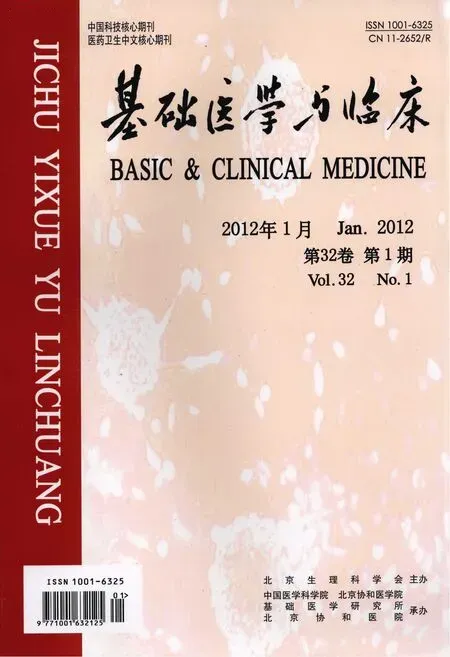树突状细胞在银屑病致病机制中作用的研究进展
王 燕,赵京霞,刘 欣,李 萍
(北京市中医研究所,北京 100010)
树突状细胞在银屑病致病机制中作用的研究进展
王 燕,赵京霞,刘 欣,李 萍*
(北京市中医研究所,北京 100010)
银屑病是多种因素造成的T细胞异常活化的慢性炎性反应皮肤病,最新研究表明,在T细胞被激活前,树突状细胞(DCs)的活化才是银屑病发生的起始和关键。正是因为DC数量增多、刺激T细胞能力增强、分泌多种细胞因子及化学增活素,形成“细胞因子风暴”,从而导致银屑病的红斑。
树突状细胞;银屑病
*通信作者(corresponding author):liping411@yahoo.com.cn
1 DC的概述
树突状细胞(Dendritic Cells,DCs)是由美国学者Steinman和Cohn等于1973年从小鼠脾组织中分离发现的,因其形状具有树突样或伪足样突起而得名,能够显著刺激初始T细胞增殖,是体内功能最强的抗原提呈细胞[1]。DC表面标志较多,但缺乏特异性;其表达多种黏附分子及共刺激分子[2-3]。
DC起源于骨髓多功能造血干细胞CD34+,发育为DC前体细胞后,随血液分布于非淋巴组织及实质器官,并发育为未成熟DC,进而在炎性介质及其他一些刺激物作用下成熟。随后,它通过淋巴管迁移至淋巴结内,分泌趋化因子和细胞因子激活T淋巴细胞,产生特异性免疫应答。DC可以激活初始T细胞(naive T cell,Tn),使其进一步分化成Th1细胞、Th2细胞、Thl7细胞或调节性 T细胞(Treg)等[4]。
其中,Th1/Th2之间的平衡在免疫应答中起重要作用。正常机体的Th1/Th2型细胞因子处于动态平衡,当这个平衡失调并向Th1或Th2转化时,称为Th1/Th2的偏移,与银屑病等许多疾病的发生、发展、治疗和转归有密切的关系。研究表明,DC是维持这一平衡的关键因素[5]。
Thl7是一种新发现的与IL-23相关的、能够分泌IL-17的T细胞亚群。Thl7细胞能参与前炎性反应,同时也能诱使自身免疫病的发生。Treg细胞为体内一类具有独特免疫调节功能的T细胞亚群,发现Treg细胞的持续表达对抑制免疫反应和维持机体的免疫耐受状态起重要作用[4]。
2 DC在银屑病中的作用机制
2.1 外周血及表皮DC在银屑病中的数量增多、功能增强
目前研究与银屑病有关的DC主要分布在外周血及皮肤处。寻常型银屑病患者外周血DC的抗原提呈能力和激活T淋巴细胞的功能增强,而且促进TH0向TH1分化的能力增强[6]。在表皮的树突状细胞主要是朗格汉斯细胞(langerhans cell,LC),银屑病患者皮损区LC的数量较非皮损区明显增多,且吞噬能力显著高于正常对照组,皮损区LC的CD1a及HLA-DR表达明显多于健康皮肤,治疗后随着临床症状的改善,组织病理的好转,CD1a、HLA-DR表达亦减少[7]。
2.2 DC与T细胞之间的关系在银屑病中的作用
DCs和T细胞之间的相互作用及相应的下游反应在银屑病皮损形成中起到非常关键的作用。银屑病患者的皮损处存在大量的 pDCs、成熟 DC及CD11C+DCs。pDCs的数量在银屑病患者的正常皮肤中也有所增加,并与皮损发展密切相关[8]。大量成熟的DC直接激活T细胞,产生TNF-γ,使角质形成细胞产生IL-8和中性粒细胞趋化因子,中性粒细胞和CD8+Tc1细胞运动到表皮,促使活化的T细胞和DC产生IFN-γ,导致角质形成细胞的增生反应,释放额外的促炎性因子。这一系列的结果增加了角质形成细胞的分化和不正常成熟,显示为表皮突的延伸,颗粒层的受损和角化不全,是银屑病的标志[9]。总之,一旦T细胞和DC被激活,将产生许多细胞因子、化学增活素及生长因子,构成“细胞因子风暴”,一场恶性循环在附近的角质形成细胞、内皮细胞、中性粒细胞和免疫细胞中发生,他们共同导致银屑病的红斑;巨噬细胞也在局部出现,可扩大局部的炎性反应或局部的免疫反应,使银屑病加重[10]。
2.3 DC分泌的细胞因子在银屑病中的作用
目前已明确由DCs所分泌的,与银屑病相关的细胞 因 子 包 括 TNF-α,IFN-γ,IL-12,IL-23 和IL-15[11]。其中研究较多的是 IL-12 及 IL-23,它们是T辅助细胞的始动者,能引发炎性反应[12]。
银屑病患者血清中IL-12水平与正常人相比明显升高,提示IL-12在寻常银屑病发病中也发挥重要的作用。IL-12是Th0向Th1分化的重要细胞因子,它可增强细胞免疫应答,如促进细胞毒性淋巴细胞的细胞毒性作用和增强自然杀伤细胞的杀伤作用,并诱导其分泌 IFN-γ[13]。
银屑病患者皮损区角质形成细胞和真皮中有IL-23mRNA的表达,其表达高于患者非皮损区皮肤及正常人皮肤,银屑病皮损区中的P19mRNA是非皮损区的22.3倍,P40mRNA是非皮损区的11.6倍;表达P19mRNA的细胞也表达单核细胞和成熟树突状细胞(DC)的表型,体外培养见刺激单核细胞和单核细胞来源的DC可上调其P19mRNA和P40mRNA 的表达[14]。
IL-23还能活化T辅助细胞,从而释放IL-17和IL-22。这些细胞因子导致表皮的炎性反应和真皮银屑病样皮损的形成。Th17细胞被异常活化,并释放大量细胞因子,作用于角质形成细胞及其他亚型Th细胞,使其增生,分泌炎性因子,同时表达某些趋化因子。这些细胞因子相互作用形成持久性炎性反应,最终演变为皮肤的慢性炎性损害[15]。
此外,IFN-α存在于银屑病皮损中,能促进T细胞增殖并激活T细胞,且与皮损形成相关[15],IL-15作为一个促炎因子可以促使T细胞增殖以及皮肤增生[16]。
3 DC的研究展望
DC具有重要的抗原提呈功能,随着DC在银屑病中作用的研究不断深入,人们认识到DC在银屑病的发病中作用重大,近年来针对DC对T细胞激活产生相关细胞因子的免疫疗法在临床上取得一定的疗效,相信随着对DC在银屑病中的作用的深入了解,人们会有更多好的方法来提高银屑病的疗效。
[1]Baumgart DC,Thomas S,Przesdzing I.Exaggerated inflammatory response of primary hu-man myeloid dendritic cells to lipopolysaccharide inpatients with inflammatory bowel disease[J].Clin Exp Immunol,2009,157:423 - 436.
[2]Chikileva IO,Anisimova NY,Lebedinskaya OV,et al.Major propertiesof dendritic cells and their actual and potential applications in cancer therapy and infectious disease prophylaxis[M]//Kiselevsky MV.Atlas effectors of Anti-Tumor Immunity.Russia:Springer,2008:111 -159.
[3]Doulatov S,Notta F,Eppert K,et al.Revised map of the human progenitor hierarchy shows the origin of macrophages and dendritic cells inearly lymphoid development[J].Nat Immuno,2010,11:585-593.
[4]Yawalkar N,Tscharner GG,Hunger ER,et al.Increased expression of IL-12 p70 and IL-23 by multiple dendritic cell and macrophage subsets in plaque psoriasis[J].J Dermatol Sci,2009,54:99 -105.
[5]Sarika J,Iqbal RK,Shukla D,et al.T helper 1 to T helper 2 shift in cytokine expression:an autoregulatory process in superantigen-associated psoriasis progression?[J].Med Microbiol,2009,58:180 -184.
[6]杨莉,戴二黑,李艳佳.银屑病患者外周血树突状细胞功能的体外研究[J].临床检验杂志,2008,26:302-303.
[7]Leanne M,Huang J,Krueger GJ.Cytokine-producing dendritic cells in the pathogenesis of inflammatory skin diseases[J].J Clin Immun,2009,29:247-256.
[8]Lowes MA.Increase in TNF-a and inducible nitric oxide synthase-expressing dendritic cells in psoriasis and reduction with efalizumab(anti-CD11a)[J].PNAS,2005,102:19057-19062.
[9]Albanesi C.Chemerin expression marks early psoriatic skin lesionsand correlates with plasmacytoid dendritic cell recruitment[J].The Rockefeller University Press,2008,206:1249-258.
[10]Zaba CL,Fuentes-Duculan J,Eungdamrong J,et al.Identification of TNF-related apoptosis-inducing ligand and other molecules that distinguish inflammatory from resident dendritic cells in patients with psoriasis[J].J Allergy Clin Immun,2010,125:1261-1268.
[11]Lowes MA.Pathogenesis and therapy of psoriasis[J].Nature,2007,445:866-873.
[12]李瑾,韩维宜.银屑病与白介素-23和白介素-12[J].中国麻风皮肤病杂志,2008,7:549-551.
[13]Gee K,Guzzo C,Che M,et al.The IL-12 family of cytokines in infection,inflammation and autoimmune disorders[J].Inflammation& Allergy-Drug Targets,2009,8:40-52.
[14]Lima HC,Kimball AB.Targeting IL-23:Insights into the pathogenesisand the treatment of psoriasis[J].Indian J Dermatol,2010,55:171 -175.
[15]Kristine E,Nograles MD,Batya MD,et al.New insights in the immunologic basis of psoriasis[J].Psoriasis and Biologics,2010,3:3 -9.
[16]Roberson E,Bowcock AM.Psoriasis genetics:breaking the barrier[J].Trends in Genetics,2010,26:415-423.
The research progress in the role of dendritic cells in psoriasis pathogenesis
WANG Yan,ZHAO Jing-xia,LIU Xin,LI Ping
(Beijing Institute of Traditional Chinese Medicine,Beijing 100010,China)
Psoriasis is a chronic inflammation of skin caused by abnormal activation of T cells.Recent research shows that before the T cells are activated,the activation of Dendritic Cells(DCs)is the early-phase and pivotal process in the occurrence of psoriasis.Just because the quantity of DCs increase,their ability of stimulating T cells enhances and they secrete multiple cytokines which form the“cytokine storm”that leads to the erythema of psoriasis.
dendritic cells;psoriasis
R 392.32
A
1001-6325(2012)01-0096-03
2010-08-23
2011-02-17
国家自然科学基金(81072810)
book=98,ebook=151

